Speech International Economic and Financial Issues: An RBA Perspective

Glenn Stevens
Deputy Governor
Address to Australian Banking & Finance News Magazine
Asia Australia Investment Conference & Expo
Sydney –
PDF version 95KB
Let me begin by thanking Australian Banking & Finance News Magazine for the invitation to speak to you today. It is very pleasing to see such a distinguished group of speakers talking about the financial services industry in the region, an activity in which Australia, and especially Sydney, is very heavily involved.
I have been asked to give a perspective on the international economy. This is something of a change of gear from most of the other presentations you have heard today, and as I set out to prepare these remarks I wondered what I might say that would retain your attention. On reflection, however, I think the current state of the world economy is of quite some interest for those who are involved in the financial services sector. Moreover, there are some long-run trends where the financial services sector's role will be critical. I'd like to explore some of these issues briefly in the time available.
I will not say much at all about the Australian economy, because the focus here is on the region and the world. Of course, the Bank's views about the Australian economy were spelled out in detail in the Statement on Monetary Policy released last Friday. This week we have also had the Budget. That is surely enough to digest on Australia.
What's happening in the global economy at present?
Let me begin by talking about where we are. The global economy, and especially the Asian region, has seen its share of fluctuations over the past few years. On the latest estimates it appears that, as measured by the IMF, the world economy expanded by about 2½per cent in 2001. This was about half the pace recorded in 2000, which was an exceptionally strong year.
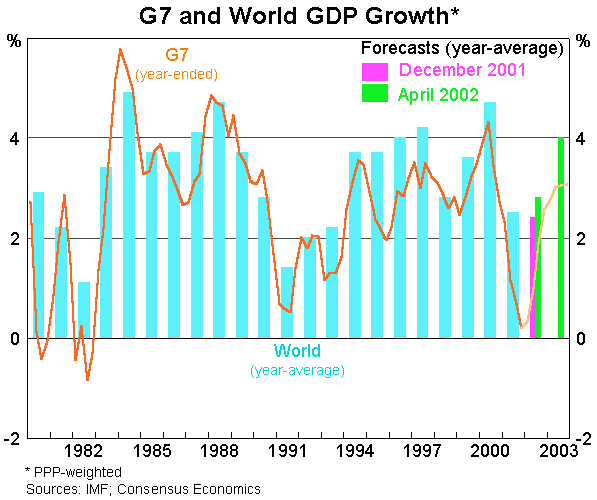
Growth in the major industrial countries (the G7) was even lower. Over the four quarters to the end of 2001, real GDP for this group of countries recorded almost no growth, which was the weakest result in any twelve-month period since the early-1980s global recession. This reflects, of course, the fact that the USeconomy experienced a recession during last year, and so did Japan and Germany.
Yet this outcome was better than might have been thought likely. During the second half of 2001, people began to worry that the US in particular would encounter a more severe and protracted recession than has, in fact, turned out to be the case. We at the RBA became quite concerned about this as well, not so much because of the terrorist attacks per se – whose direct short-term economic impact we thought likely to be relatively small– but simply because economic problems can accumulate towards the end of long expansions, which then intensify any subsequent downturn. Arguably, the US economy had acquired some such imbalances– with some asset values falling from very high levels, an unusually high level of business investment raising the question of whether there might have been over-investment, and questioning in some quarters about whether consumer spending had run too far ahead of income.
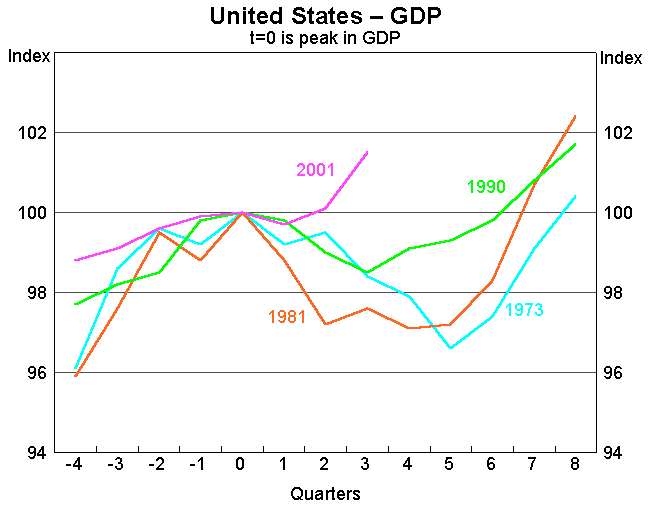
As things have turned out, fears of a sharp slump have not been realised. On the contrary, as of May2002, it seems that the US has begun to recover from what now appears to have been the shallowest recession in recent history, at least as measured by the behaviour of GDP. Using the metric of unemployment, if it wasn't the shallowest recession in recent times, it was close. This is a better outcome than most thought likely during the second half of last year, and is much better than the "downside risk" scenarios which were contemplated at that time.
Reflecting these outcomes, forecasters stopped continually downgrading their assessments about the future earlier this year, and have become more confident over recent months that global economic activity will strengthen as 2002 progresses and that 2003 will be a pretty good year. They expect this to be led by an improving US, with Europe and East Asia turning up as well. Not much contribution to growth is expected from Japan in the short term, but at least performance there is not expected to worsen.
There is, of course, a long way to go to see whether those expectations turn out to be correct, but they are not unreasonable expectations to hold in the present circumstances. The US turning point is clearly already behind us. It is pretty obvious, furthermore, that macroeconomic policies in the US are exerting a considerable expansionary impetus. In fact, monetary policies in almost all countries have been quite easy over the past year, which in itself increases the probability that growth will strengthen rather than fade away. In short, while it is not time to throw our hats in the air about the world economy, things look distinctly better than six months ago.
Aspects of the US economy
It is worth dwelling for a little while on the recent experiences of the US, and not just because it is the world's largest national economy in terms of production of goods and services. The USeconomy is also a dominant force affecting global capital markets, and in the past five years it has been subject to some unusual influences which are still running their course.
There has been a remarkable degree of investment in information technology and communication capacity in the US. This has been a feature of other countries too, but it was most pronounced in the US, raising the share of overall business investment in GDP to historically high levels in the late 1990s. Expectations about returns to this investment have, until quite recently at least, been very optimistic. For that reason, the US has been a powerful magnet for capital, and much of America's additional investment has been funded with savings sourced in other countries. Associated with that has been a rising level of the USdollar, high levels of domestic asset prices and hence substantial gains in household wealth. That, in turn, helped to support a prolonged period of strength in household consumption spending. All of this contributed to a robust and lengthy period of economic expansion until early 2001.
It is striking, moreover, that this long expansion followed a pretty mild recession in the early 1990s, which had itself followed a pretty good expansion in the 1980s. So, in fact, the US has had a good two decades by the standards of other advanced economies, with its performance outstripping those of Europe, or Japan, with the margin quite wide during the 1990s. This persistent out-performance by the USeconomy has made it the benchmark for most things economic and financial. The dominance of the USmodel of market capitalism seemed, by the end of the 1990s, to be unassailable.
The role of the financial sector in all this, moreover, was pivotal. USequity and debt markets channeled vast quantities of capital into the corporate sector, and especially the high-tech sector, at quite low cost. In 2000, equity market issuance by US corporates was eight times the rate just three years earlier, at price-earnings ratios which were exceptionally high. This rapid increase in the supply of almost costless equity capital seems to have been driven by the conviction that returns from some of the new technologies would be enormous for their producers and, dispersed across the USeconomy, their users in terms of productivity. The financial services sector provided the machinery for all this to happen, itself using the improvements in information and communications technology to lower its costs.
Up to a point, this was a model of what the financial sector is supposed to do: allocate capital, and by seeking out the highest returns, maximise the growth potential of the economy. Regrettably, as often happens in a prolonged boom, excesses emerged. Investors increasingly tended to become mesmerised by the apparent success of firms with business models whose worth, in more sober times, would have been regarded as dubious. In addition, practices developed in some areas which, in hindsight, are pretty hard to defend. Statements of corporate earnings, for example, turned out to be quite misleading in some celebrated instances, raising questions about the behaviour of management, and the role of auditors. Distorted incentive structures and accounting rules are seen as having contributed to this process, and to the fact that the advice given by analysts to their clients was, in a number of cases, less than impartial. And so on.
I do not recount this to point fingers of blame at anyone in particular– it is, I fear, part of the human condition that such things happen near the end of most booms, even ones whose initial development is well based in fundamentals. The temptation to talk up prospects, and the desire on the part of investors to believe the talk, becomes almost irresistible. But these things do have real costs: capital is misallocated, or simply lost; as a result, someone's savings are depleted, and the economy is the poorer for not having used those resources more wisely. Hence the importance of the financial sector's role in the economy.
What appears to be occurring now is that pressure is building in the US for reforms to the problem areas. Without wanting to speculate about the outcomes, most would agree that some reforms will help to re-build confidence, which is beneficial for the finance industry in the US and, by extension, globally. We should keep in mind, though, that that will not stop the tendency towards extremes of optimism and pessimism– that's just human nature.
All that said, any legacy from all this has not stopped a recovery in the US economy from beginning, even though it may well have some impact on the shape of it. Over recent months, people have switched from debating the possible size of the downturn to talking about the likely strength of the upswing. The spurt of US growth in the March quarter was largely driven by a rise in production in the goods-producing part of the economy, where previous levels of production had been sufficiently low that inventories of goods had been falling. The current level of production can be sustained, but for ongoing growth in production what is needed is expansion in demand and prospects for demand are regarded as, to use the current language of choice, "uncertain". It is not that demand is falling– it is growing. The issue is to what extent, and how soon, it might accelerate.
In this context, the behaviour of business investment has been nominated (by the Federal Reserve, for example) as crucial. After such a prolonged period of massive capital investment, there was a very sharp fall-off in capital spending by USbusinesses during 2001. It was this component of demand which was responsible for pushing the USinto recession. The pace of decline looks like it began to abate in the early part of 2002, but it is not clear when investment spending might actually pick up again.
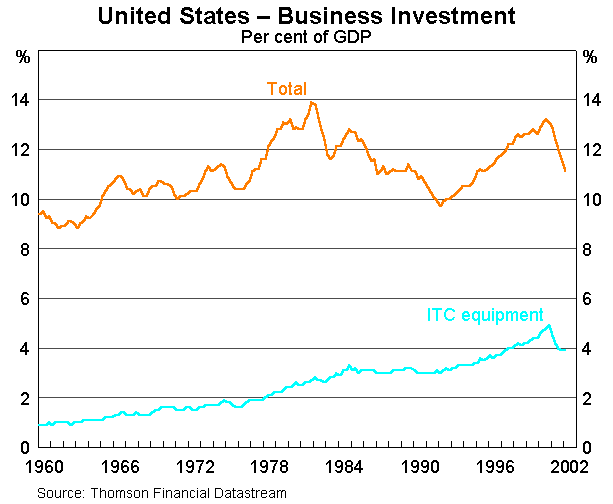
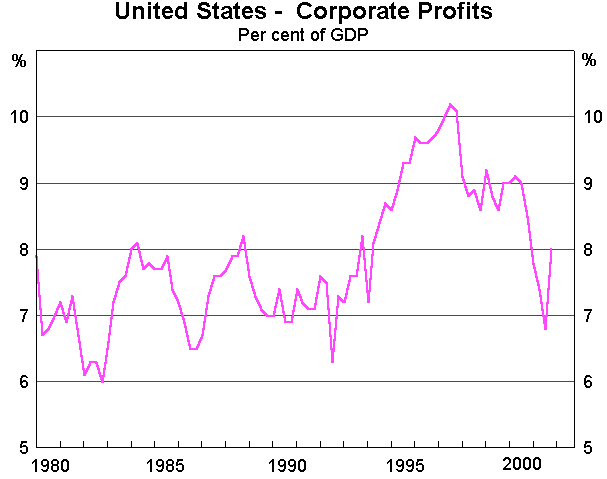
Central to the outlook for investment will be the state of UScorporate profits. The chart shows the best available measure of economic profits, from the USnational accounts, measured as a share of USGDP. There was a period of strong profit growth from 1994 to 1997, but then the profit share tended to drift lower, before falling sharply during the first nine months of 2000. UScorporations acted to reduce costs with alacrity over the past year. Profits then began to recover in the last quarter of 2001 and, based on preliminary information for the March quarter, that has probably continued.
Equity analysts who make forecasts are expecting continued very strong growth in earnings over the coming year. Those inclined to have reservations about the robustness of the USrecovery would wonder whether earnings growth expectations might be somewhat optimistic (and, for that matter, whether profits were actually as strong as commonly believed in the late phases of the expansion). That is not to argue that the USrecovery, which is clearly under way, will peter out, just that it might be a fairly moderate affair compared with some other recoveries.
Nonetheless, it is apparent that a pick-up of some degree is under way in profits, and even a moderate overall recovery after a fairly shallow recession is a good outcome. Furthermore, given that the US economy has surprised many by its resilience to date, there has to be the possibility that it will continue to do so.
Aspects of the Asian region
Turning to the Asian region, we have seen encouraging evidence that a number of countries have turned the corner on economic growth in the second half of 2001, after a period of contraction.
For the region as a whole, the global downturn of 2001 was much less traumatic than the Asian financial crisis of 1997 and 1998 (though this is not true for every individual country). There are a number of reasons for this but one contributing factor, in my view, was that economic policies responded differently. Floating exchange rates were allowed to decline when under pressure, which helped to avoid any sense of crisis and associated contagion from one country to another. Monetary and fiscal policies were generally eased, something which, in many instances, was not possible during the initial phase of the earlier crisis. This meant that while the global slump did affect East Asia, the effects were ameliorated, rather than exacerbated, by the policy structures and responses.
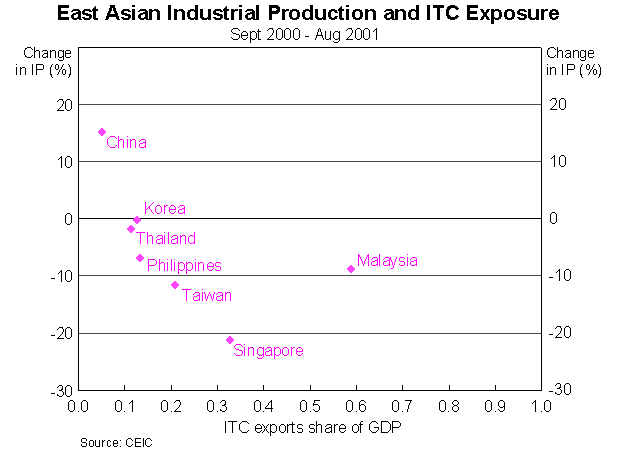
Nonetheless, the recent experience may prompt some of the East Asian economies to think about the extent of their exposure to the high-technology sector. A notable feature of performance after the Asian crisis was the way in which the global boom in that sector drove growth for the exposed economies. And in the subsequent downturn, there seems to have been, not surprisingly, some association between the degree of technology exposure and the extent of the economic slowdown across countries (see chart).
A question which these countries may face– probably they are already asking it of themselves– is whether the sorts of growth rates they want to sustain can be so reliant on a relatively concentrated, export-led approach in industries where the products are increasingly commoditised, or whether a more diversified approach, including more growth in domestic demand, would be better. The answer which emerges will no doubt be important for trade and capital flows in the region in the future.
No less important than that set of issues, and in many respects quite related to it, is the potential long-run impact of the rapid growth and internationalisation of the Chinese economy. China's economic growth, at least as recorded by the official data, is remarkable for its pace and consistency during the past decade. China is fast becoming quite large as both a source of, and a destination for, goods and services. It is the second largest regional economy after Japan, for example, by a large margin. It is also a very large destination for international capital, receiving a significant share of the world's cross-border flows of direct investment in recent years (see table).
| US$ billion | |
|---|---|
| Asia | 56 |
| of which China | 38 |
| Western hemisphere | 38 |
| "Transition" countries of Eastern Europe | 23 |
| Other | 47 |
| All emerging markets | 164 |
Some of my colleagues in the RBA point out that the associated build-up of manufacturing capacity in China must have something to do with the tendency for international prices for manufactured products to decline over recent years, even in periods where global growth was pretty strong. Equally, the rapid growth of income and wealth in China will boost demand from that country, and presents opportunities for foreign companies, not least in financial services and communications. So China is becoming increasingly important for the international, and especially the regional, economies. Other countries have an increasing interest in the success of the efforts of the Chinese authorities to achieve balanced growth, financial stability and efficient allocation of the capital resources which are flowing into China from abroad.
The Japanese economy remains in a very difficult position. A decade ago, no-one would have predicted that Japan, an economy which recorded extraordinary growth for a generation, would struggle to grow by an average of 1½ per cent per year during the 1990s. The mix of factors at work is quite a potent one, and includes again the aftermath of a period in which the financial system (among other things) did not function as it should have. Asset prices have fallen massively since the heady peak reached in the "bubble economy" period a decade or so ago. Hence the value of collateral for bank loans has also collapsed, putting enormous strain on corporate borrowers and the financial system. The general level of prices is declining. Government finances are strained to the limit after a long sequence of fiscal packages. Monetary policy has lowered short-term interest rates to zero, and pushed an enormous quantity of cash into the system in an attempt to get some expansionary impetus to an economy where there has been no appetite for borrowing. In this respect, the debate about macroeconomics in Japan has seen the return of a number of themes prominent in the 1930s, and it is proving much more difficult to get Japan's growth moving and its prices back to small positive rates of increase than most people would have expected. The US authorities have observed these problems and my belief is that their desire to avoid encountering such a scenario helps explain the aggressive nature of the monetary policy reaction of the Federal Reserve during 2001.
The world economy would surely be better off were Japan to be able to make a decisive return to solid growth, but in the short term, forecasters seem to have little confidence that that will occur. Still, if Japan performs in future like the average of the past few years, a pick-up in growth in other countries will see better global conditions.
Europe
Europe's economies slowed noticeably in 2001. Germany, in years past the strongest of the major European economies, has under-performed some others in recent years, such as France or the UK, and in 2001 saw a contraction in output in the second half of the year.
In recent months, there have been some encouraging signs of a turn for the better, with surveys of business confidence generally looking firmer. Most people expect that trend to continue, though business people in Europe are presumably concerned about the current industrial unrest.
The financial services sector and regional economies
Other speakers today have no doubt talked at length about the growth prospects for the financial services sector around the region, so I will not say much on that, but a few remarks are possibly in order.
As an economy develops, the wealth of the community increases, and an increasing proportion of it is held in the form of financial claims. Banking systems develop and, usually later, capital markets where companies and governments can tap savings directly.
In the old western industrial economies, this process typically took quite a long time. In Asia, these developments have been accelerated, as part of the rapid industrialisation and development of these economies in the past generation. By now, in some cases the sizes of financial systems are getting pretty large. In countries such as Malaysia, China and Korea, some very crude calculations (shown below) suggest that financial assets are, relative to the size of the respective economies, getting to be as large as those in many high-income countries. In Singapore and Hong Kong, operating offshore financial centres, financial systems are also, of course, fairly large.
| US$ billion | Per cent of GDP | |
|---|---|---|
| Japan | 14,026 | 338 |
| China | 2,288 | 198 |
| Hong Kong | 910 | 562 |
| Korea | 842 | 199 |
| India | 533 | 111 |
| Australia | 790 | 221 |
| Thailand | 203 | 177 |
| Singapore | 257 | 291 |
| Malaysia | 296 | 338 |
| Indonesia | 105 | 72 |
| Philippines | 66 | 93 |
| USA | 28,451 | 279 |
|
(a) Calculated as monetary assets, plus bonds and equities. Data for 2001–02 Sources: IMF, BIS, FIBV |
||
In several countries, a good deal of repair work is being done on banking systems whose net worth was seriously eroded by the Asian financial crisis in 1997 and 1998. While this has often been labelled as a currency crisis, at its heart it was also a banking crisis. Banks– and not just the ones on the ground in Asia– did not perform the function of allocating capital and managing risk as well as they should have. Lest this comment sound patronising, I hasten to add that we in Australia had an experience of a similar nature, though thankfully of a smaller order of magnitude, in the late 1980s and early 1990s. Indeed, most countries have had this happen at some stage, and usually more than once.
In the past ten to fifteenyears, the experience in the old industrial countries has resulted in a strengthening of risk management in banks and in the supervisory process, something which is now being worked on in Asia.
The authorities in a number of Asian countries are also seeking to promote capital market development so as to lessen their high degree of reliance on banking systems. It has been suggested that in times of stress, having more than one conduit for the provision of funding is a handy degree of diversification. Share markets have long been a feature of the Asian financial landscape and now bond markets are developing more quickly. China again features here, with a stock of bonds outstanding now second only to Japan's in size in the region.
The future seems likely to involve considerable further growth in the financial systems of many of the countries of Asia. I would think that Australian market participants are particularly well-placed to take part in the development of these markets, given the maturity and sophistication of our markets for sovereign and corporate debt, and derivatives markets which are quite active and reasonably large in world terms.
Conclusion
The world economy appears to be gradually improving, and we are seeing this reflected in better conditions for many of the Asian region's economies. We are still unsure how things will pan out in the US, but the fact that we can debate the strength of an upswing, as opposed to the depth of recession, is a clear indication that things have been going better than expected.
In this region, there remain some short-term problems, but there are also some quite important medium-term trends– of which I would nominate the rapid growth of China as probably the most important. The role of the financial services sector is key in accommodating these trends and in helping savers and investors alike to maximise their opportunities. I am sure you all have fascinating challenges ahead.